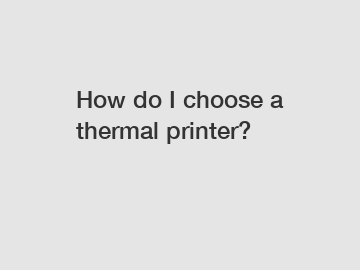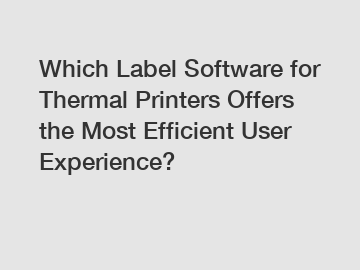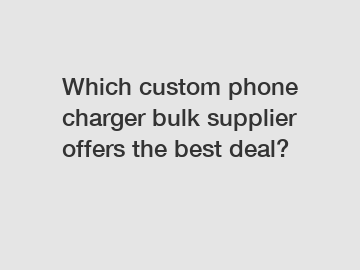How do I choose a thermal printer?
In today's fast-paced digital world, thermal printers have become an essential tool for various industries. Whether you own a retail business, operate a logistics company, or work in healthcare, choosing the right thermal printer is crucial for seamless operations. With a multitude of options available on the market, it can often be overwhelming to make the right choice. But fear not! In this article, we will guide you through the process of selecting the ideal thermal printer, ensuring it aligns with your specific requirements.
1. Assessing Your Needs.
Before diving into the abundant options, start by assessing your business needs. Consider the printing volume, the size and quality of labels required, and the level of integration necessary with your existing systems. Think about the environment in which the printer will be used and any special features you may require, such as wireless connectivity, barcode printing capabilities, or waterproofing for harsh conditions.

2. Understanding Different Types of Thermal Printers.
Thermal printers fall into two main categories: direct thermal and thermal transfer printers. Direct thermal printers use heat-sensitive paper to produce labels, while thermal transfer printers use a heated ribbon to transfer the ink to the paper. The choice between the two depends on a variety of factors including durability, cost, and the intended application. Direct thermal printers are ideal for short-term label printing (e.g., shipping labels), while thermal transfer printers are best suited for long-lasting labels (e.g., product labeling).
3. Assessing Print Quality.
Print quality is a crucial aspect when selecting a thermal printer. Consider the resolution, measured in dots per inch (DPI). Higher DPI generally translates to crisper, more detailed prints. However, for standard labeling purposes, a minimum of 203 DPI is usually sufficient. Look for printers that offer both text and image printing capabilities, providing versatility for your business needs.
4. Evaluating Speed and Efficiency.
Efficiency plays a significant role in managing your business operations smoothly. Assess the speed at which a thermal printer can produce labels and compare it to the workload demands of your business. Do you need a printer that can support high-volume printing without compromising speed? Look for models that offer speedy output while maintaining consistency and accuracy, ultimately saving you time and resources.
Explore more:Consumer Electronics
Convenient and Affordable: Bulk Portable Phone Chargers
What is the best brand of LED walls?
What are the advantages of purchasing a 5 MP CMOS camera module?
Pharmacy Thermal Printers: Top Solutions for Efficient Medication Labeling
Why are USB-C to C cables so expensive?
7 Top Curved LED Screen Applications in 2021
5. Connectivity and Compatibility.
Today's businesses thrive on seamless integration and connectivity. Ensure the thermal printer you choose seamlessly integrates with your existing systems or software. Consider compatibility with your point-of-sale (POS) system, inventory management software, or shipping platforms. Wireless connectivity options, such as Bluetooth or Wi-Fi, can enhance versatility and convenience, allowing you to print labels from any device in your network.
6. Reliability and Durability.
A reliable and durable thermal printer is a valuable asset for any business. Look for models that offer robust construction and can withstand the demands of your working environment. If your operations involve exposure to extreme temperatures, moisture, or other harsh conditions, opt for printers with IP-rated enclosures to ensure durability and longevity.
7. Budget Considerations.
Last but not least, your budget should dictate your final choice. Evaluate the printer's upfront cost, maintenance expenses, and the cost of consumables like thermal paper and ribbons. Remember, while it may be enticing to opt for the cheapest option, investing in a quality thermal printer will save you from potential issues and extra costs in the long run.
Conclusion.
Choosing the right thermal printer is essential for streamlining your business operations and optimizing productivity. By assessing your needs, understanding the different types of thermal printers, considering print quality, efficiency, connectivity, reliability, durability, and staying within your budget, you can make an informed decision that will benefit your business in the long term. Remember, it's always worth investing in a printer that aligns perfectly with your requirements, ensuring seamless printing and enhancing your overall business performance.
If you are looking for more details, kindly visit medical barcode printing software, canned food labeling machine, epson pos 80 printer driver.
Explore more:What are the different types of camera zoom?
Unlocking the Secrets of Gainscha.com.tw
What are the top 10 customized car chargers options for businesses looking to enhance their brand visibility?
Boost Sales with Top-Notch Price Tag Printers: Expert Buying Guide!
Why not to buy cheap chargers?
Boost your business with impactful digital signs - Uncover the top solutions now!
Which Raspberry Pi Camera V2 is the best for panoramic photography?










